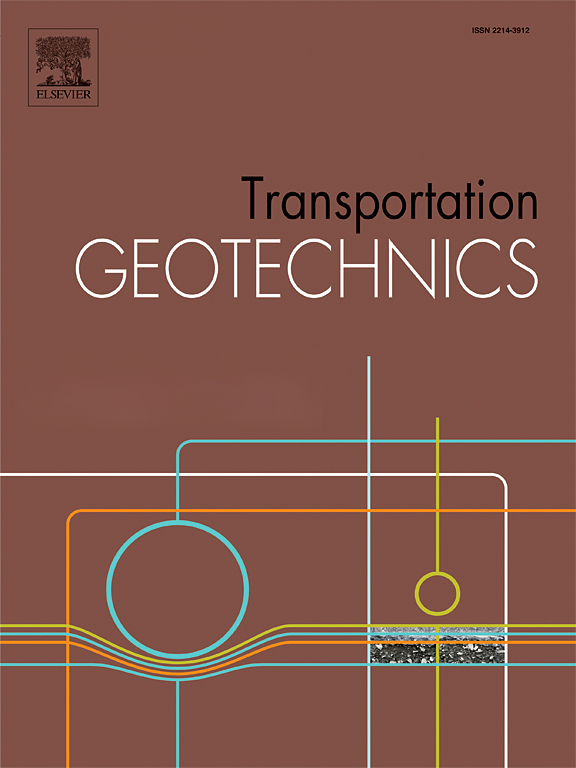埋地水管在极端寒潮前后对交通负荷的机械响应
IF 4.9
2区 工程技术
Q1 ENGINEERING, CIVIL
引用次数: 0
摘要
近年来,寒潮等极端天气事件发生的频率和强度不断上升,加剧了人们对其对埋地输水管道影响的担忧,给城市安全带来了显著挑战。这些管道尤其容易受到寒潮引起的极端低温的破坏,从而导致严重的系统故障。本文采用有限元法 (FEM) 研究了寒潮前后埋地输水管道对交通荷载的机械响应。首先,利用在中国东部上海市寒潮期间收集的现场监测数据,创建了一个三维数值模型,以模拟土壤和埋地管道中的温度分布。随后,将验证的土壤和管道温度场作为预定义场,对土壤-管道模型进行了力学分析。详细讨论了温度变化率、交通荷载类型、荷载位置和埋深对管道行为的影响。结果表明,寒潮会对管道应力产生显著影响,而交通荷载的增加会加剧这种影响。在 1.0 兆帕载荷下,米塞斯应力峰值增加了 21%,这说明了冷波在放大管道应力方面的作用。此外,虽然寒潮会增加管道应力和垂直位移,但加快寒潮引起的温度变化速度会降低应力。交通荷载对喇叭口和拉钉接头上的影响最大,无论接头上的位置如何,影响都是一致的。这项研究表明,浅埋管道的喇叭口和拉钉节极易受到寒潮的影响,尤其是在交通荷载下,因此在这种情况下有必要特别关注这一潜在的失效位置。本文章由计算机程序翻译,如有差异,请以英文原文为准。
Mechanical response of buried water pipes to traffic loading before and after extreme cold waves
In recent years, the escalating frequency and intensity of extreme weather events like cold waves have heightened concerns regarding their impact on buried water pipelines, posing notable challenges to urban safety. These pipelines are particularly vulnerable to damage from the extreme low temperatures induced by cold waves, which can lead to significant system failures. This paper investigates the mechanical response of buried water pipelines to traffic loading before and after a cold wave using the Finite Element Method (FEM). Initially, a 3D numerical model was created to simulate the temperature distribution in the soil and buried pipe, utilizing field monitoring data gathered during a cold wave event at Shanghai city of Eastern China. Subsequently, a mechanical analysis of the soil-pipe model was conducted, employing the validated soil and pipe temperature field as predefined fields. The effects of temperature change rate, traffic load type, load position, and burial depth on the pipeline behavior are discussed in detail. The results demonstrated that cold waves significantly impact pipeline stress, an effect that is intensified by increased traffic loads. The peak Mises stress increased by up to 21 % for the 1.0 MPa load, underscoring the role of cold waves in amplifying pipeline stress. Moreover, while cold waves increase pipeline stress and vertical displacement, accelerating the rate of temperature change induced by the cold wave reduces the stress. Traffic load exerts the most significant impact at the bell and spigot joints, with effects remaining consistent regardless of joint position. Shallow-buried pipelines experience more pronounced stress changes in the presence of cold waves and traffic load, with stress increasing by 66.8 % at a depth of 1.5 m. This study demonstrates that the bell and spigot joints of shallow-buried pipes are highly susceptible to cold wave effects, especially under traffic loading, necessitating special attention to this potential failure location during such conditions.
求助全文
通过发布文献求助,成功后即可免费获取论文全文。
去求助
来源期刊

Transportation Geotechnics
Social Sciences-Transportation
CiteScore
8.10
自引率
11.30%
发文量
194
审稿时长
51 days
期刊介绍:
Transportation Geotechnics is a journal dedicated to publishing high-quality, theoretical, and applied papers that cover all facets of geotechnics for transportation infrastructure such as roads, highways, railways, underground railways, airfields, and waterways. The journal places a special emphasis on case studies that present original work relevant to the sustainable construction of transportation infrastructure. The scope of topics it addresses includes the geotechnical properties of geomaterials for sustainable and rational design and construction, the behavior of compacted and stabilized geomaterials, the use of geosynthetics and reinforcement in constructed layers and interlayers, ground improvement and slope stability for transportation infrastructures, compaction technology and management, maintenance technology, the impact of climate, embankments for highways and high-speed trains, transition zones, dredging, underwater geotechnics for infrastructure purposes, and the modeling of multi-layered structures and supporting ground under dynamic and repeated loads.
 求助内容:
求助内容: 应助结果提醒方式:
应助结果提醒方式:


